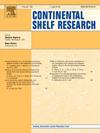2001 - 2020年舟山群岛风暴潮时空特征
IF 2.2
3区 地球科学
Q2 OCEANOGRAPHY
引用次数: 0
摘要
风暴潮对海岸造成了严重的危害,需要对其行为进行准确的建模和理解。本研究采用沿海和区域海洋群落模型对舟山群岛风暴潮的时空特征进行了研究。基于2001-2020年20多个台风季节的模拟,我们发现靠近大陆的岛屿通常比偏远的近海岛屿表现出更高的风暴潮水平,这表明岛屿在风暴潮事件中受到不同程度的风险。然而,风暴潮的具体分布取决于台风的轨迹。偏岸台风导致浪涌总体向东减弱,而在舟山以南登陆的台风则导致西南岛屿海岸的最大浪涌高度。在时间变化上,风暴潮综合强度呈轻微增加趋势,可能受台风最大强度距离减小的影响。此外,风暴潮综合强度与El Niño和La Niña事件呈正相关,特别是在风暴潮强烈的地区。研究结果可为舟山等海岛城市风险防控策略的制定提供有价值的参考。本文章由计算机程序翻译,如有差异,请以英文原文为准。
Spatiotemporal features of storm surges in the Zhoushan Archipelago from 2001 to 2020
Storm surges pose a critical coastal hazard, necessitating accurate modelling and understanding of their behavior. In this study, the Coastal and Regional Ocean Community model has been used to investigate spatiotemporal features of storm surges in the Zhoushan Archipelago. Based on simulations over 20 typhoon seasons (2001–2020), we find that islands closer to the mainland generally exhibit higher surge levels than remote offshore islands, suggesting that islands are subjected to varying degree of risk during a storm surge event. However, the specific distribution of storm surges depends on typhoon trajectories. Offshore-deviating typhoons lead to a general eastward diminution of surges, while typhoons that make landfall south of Zhoushan result in maximum surge heights along the southwestern islands’ coasts. In terms of temporal variation, storm surge integrated intensity exhibits a slight increasing trend, likely influenced by the decreasing distance of typhoon maximum intensity from Zhoushan. Furthermore, the integrated intensity of storm surge correlates positively with El Niño and La Niña events, particularly in regions characterized by intense storm surges. These findings provide valuable reference for the development of risk prevention and mitigation strategies in Zhoushan and other island cities.
求助全文
通过发布文献求助,成功后即可免费获取论文全文。
去求助
来源期刊

Continental Shelf Research
地学-海洋学
CiteScore
4.30
自引率
4.30%
发文量
136
审稿时长
6.1 months
期刊介绍:
Continental Shelf Research publishes articles dealing with the biological, chemical, geological and physical oceanography of the shallow marine environment, from coastal and estuarine waters out to the shelf break. The continental shelf is a critical environment within the land-ocean continuum, and many processes, functions and problems in the continental shelf are driven by terrestrial inputs transported through the rivers and estuaries to the coastal and continental shelf areas. Manuscripts that deal with these topics must make a clear link to the continental shelf. Examples of research areas include:
Physical sedimentology and geomorphology
Geochemistry of the coastal ocean (inorganic and organic)
Marine environment and anthropogenic effects
Interaction of physical dynamics with natural and manmade shoreline features
Benthic, phytoplankton and zooplankton ecology
Coastal water and sediment quality, and ecosystem health
Benthic-pelagic coupling (physical and biogeochemical)
Interactions between physical dynamics (waves, currents, mixing, etc.) and biogeochemical cycles
Estuarine, coastal and shelf sea modelling and process studies.
 求助内容:
求助内容: 应助结果提醒方式:
应助结果提醒方式:


